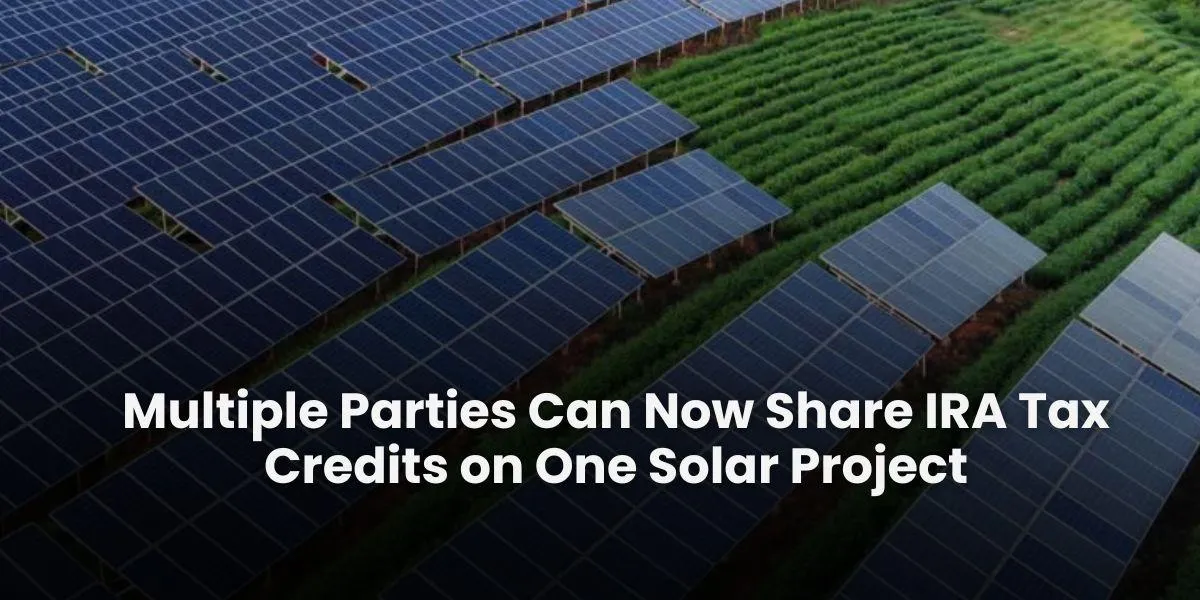Solar Industry
Latest Articles
Transparent Reporting for a Sustainable Future
Read the latest...

Multiple Parties Can Now Share IRA Tax Credits on One Solar Project
In an era where renewable energy is pivotal to combating climate change, the recent updates to the Inflation Reduction Act (IRA) offer significant advantages for co-owned solar projects. This article explores how these direct pay rules can empower investors, enhance solar development, and promote collaborative efforts in the renewable energy sector.
Understanding the Direct Pay Mechanism
The Inflation Reduction Act introduces a direct pay mechanism that allows solar developers and investors to receive credits and rebates directly from the federal government, rather than relying solely on tax benefits. This shift in policy is particularly beneficial for co-owned solar projects, which often struggle to fully utilize investment tax credits (ITCs) due to complex ownership structures.
What Does Co-Ownership Mean in Solar Projects?
Co-ownership in solar projects typically involves multiple stakeholders sharing investment responsibilities and benefits. This collaborative approach can enhance project viability and spread financial risk, making it a popular choice among private investors, nonprofits, and community organizations. However, traditional tax credit structures posed challenges for these projects, often leading to underutilization of available incentives.
New Opportunities for Co-Owned Solar Projects
The final IRA direct pay rules unlock new opportunities for co-owned solar projects, ensuring that all participants can effectively claim their fair share of benefits. Here’s how these rules can transform solar investments:
1. Simplified Claims Process
The direct pay feature simplifies the claims process for solar tax credits. Co-owners no longer have to navigate complex arrangements to take advantage of their ITCs. Instead, they can receive a cash payment equal to the credit amount, making it easier for projects to secure funding and encouraging more investors to participate in the solar market.
2. Enhanced Cash Flow
With direct pay, co-owners can convert tax credits into immediate cash flow. This shift allows projects to reinvest funds into further development or operational improvements, thereby enhancing the overall financial health of the solar initiative. By addressing cash flow challenges, co-ownership becomes a more attractive model for investment.
Impacts on the Solar Market
The implementation of direct pay rules will likely have significant effects on the solar market landscape. Here are a few notable impacts:
Increased Investment in Solar Projects
The ability to receive direct payments incentivizes investment in solar projects. Investors previously discouraged by tax equity intricacies may find the new rules more appealing. This increased investment can lead to a surge in new solar developments, pushing the industry toward its growth targets.
Boosting Community Solar Initiatives
Community solar projects, which are often co-owned by local residents and stakeholders, stand to benefit particularly from these new rules. Direct pay options can transform how community solar initiatives are funded, enabling broader participation and making renewable energy more accessible to underserved populations.
Key Takeaways for Investors and Developers
Understanding the implications of the final IRA direct pay rules is essential for investors and developers in the solar industry. Here are the key takeaways:
Leverage Co-Ownership for Greater Benefits
Investors can maximize their returns by partnering in co-owned solar projects. The new direct pay rules enhance the financial viability of these collaborations, allowing for shared investments and quicker returns.
Stay Informed on Compliance Requirements
It’s crucial for stakeholders to stay updated on compliance requirements to benefit fully from the direct pay mechanism. Proper documentation and adherence to regulations will ensure seamless access to the new incentives.
A Bright Future for Co-Owned Solar Projects
The final IRA direct pay rules represent a significant step forward for co-owned solar projects, dismantling previous barriers to entry and enhancing the financial landscape for renewable energy investments. By simplifying the claims process and boosting cash flow, these rules facilitate greater collaboration among investors and communities, fostering a more inclusive and sustainable energy future.
As the solar industry continues to evolve, co-ownership models, backed by direct pay opportunities, will play a vital role in driving the transition toward renewable energy. Investors, developers, and community stakeholders should embrace this transformative moment and work together to shape the future of solar energy.

In House Contributor
Our Team At My Solar Solutions Is Committed To Bringing You The Most Up To Date Solar Industry News
